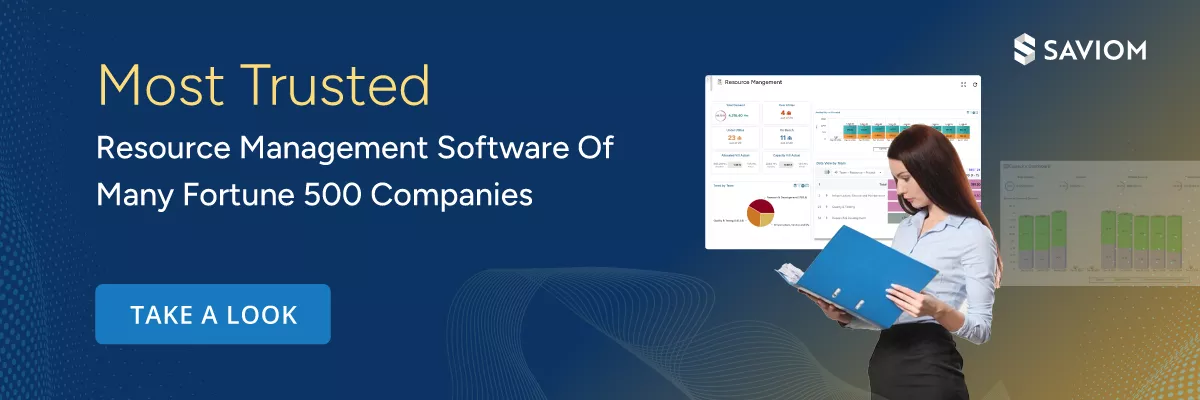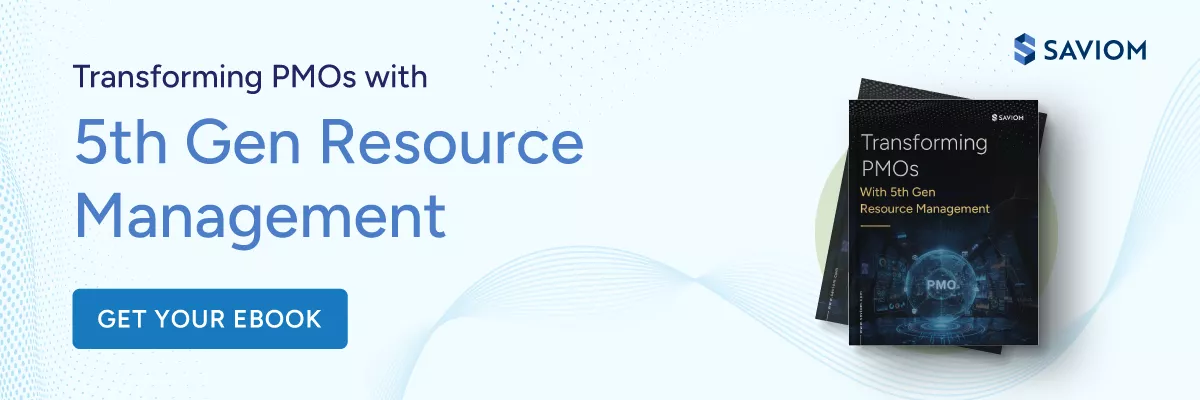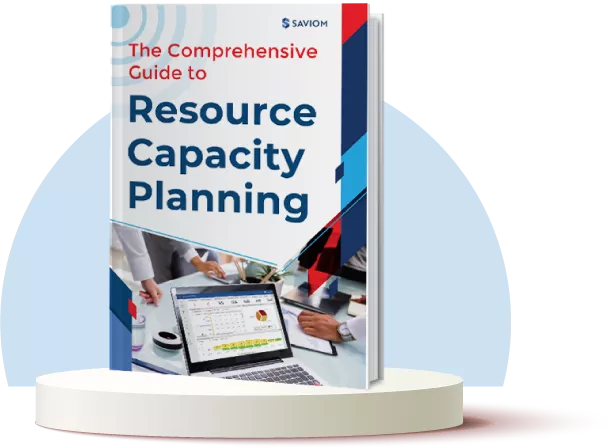Traditionally, PMOs have been the backbone of organizational success, providing governance, standardizing processes, managing resources, and maintaining project oversight. However, as project portfolios grow increasingly complex, PMOs often struggle to address resourcing challenges effectively due to their heavy reliance on outdated and legacy systems.
Since these tools lack real-time visibility and advanced mechanisms, they slow down decision-making. As a result, it impedes PMOs from effectively managing resources across portfolios, leading to subpar project delivery.
That is where 5th gen resource management steps in as a transformative force for modern PMOs. With advanced capabilities such as KPI forecasting and optimization, dynamic capacity planning, skill-based allocation, and intelligent scenario-based modeling, it empowers PMO managers to make proactive, data-driven decisions. Therefore, it helps boost workforce productivity, drive sustainable business growth, and maximize profitability.
In this article, we will dive deep into how 5th gen resource management can be a game-changer for modern PMOs, elucidating its core pillars, benefits, metrics, and best practices. Additionally, it emphasizes how SAVIOM’s robust functionalities enable PMOs to gain a competitive edge in a dynamic business landscape.
What is 5th Gen Resource Management?
5th Generation resource management is a strategic, data-driven approach designed to address the evolving resourcing needs of modern businesses. It provides PMOs with enterprise-wide visibility into critical data such as skills, costs, availability, and utilization. Moreover, KPI forecasting and optimization enable PMOs to identify early signs of underutilization, skill shortages, or employee burnout, enabling corrective measures.
Beyond that, advanced techniques like multi-dimensional forecasting, capacity planning, and dynamic resource allocation help PMOs anticipate future demand and allocate resources proactively. In addition, scenario-based modeling allows them to test various allocation strategies and select the most effective one.
Thus, with 5th gen resource management, PMOs can act promptly and prevent costly escalations like rework, last-minute hiring, or missed deadlines. Ultimately, this strengthens portfolio governance, enhances profitability, and future-proofs the workforce against market volatility.
Now that we have understood the definition, let’s move to the key elements of 5th gen resource management.
Core Pillars of 5th Gen Resource Management for PMOs
The evolution to 5th gen resource management redefines how PMOs plan, allocate, and optimize their workforce. Below are the key pillars that form the foundation of this advanced, insight-driven approach.
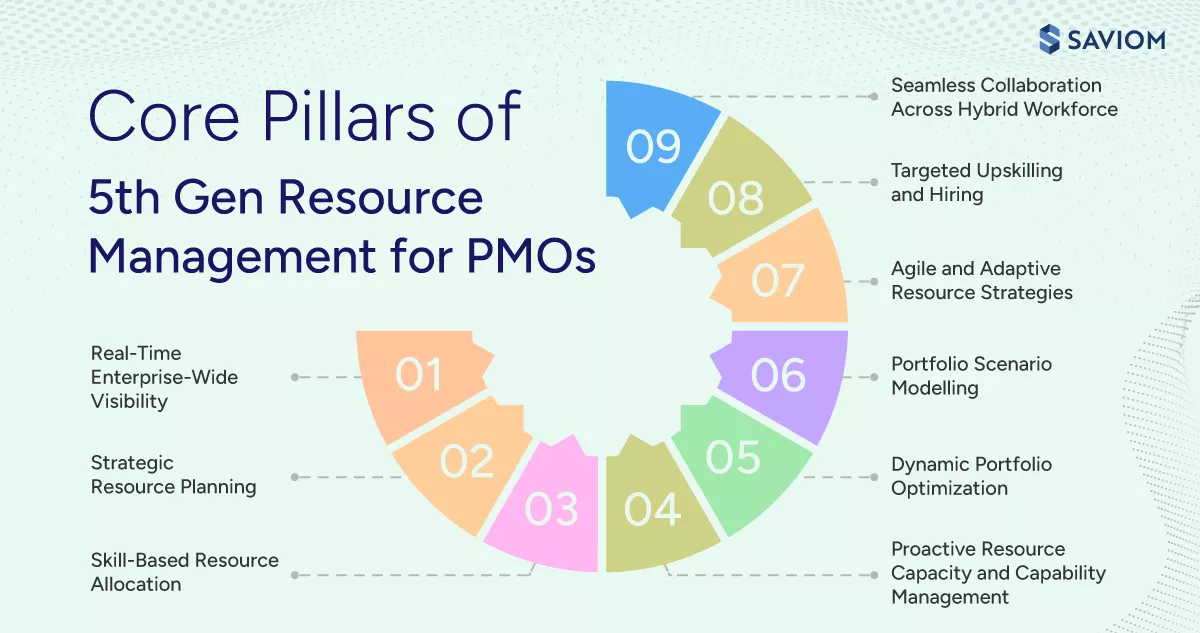
Real-Time Enterprise-Wide Visibility
Real-time, enterprise-wide visibility offers PMOs a unified view of resource data such as skills, utilization, costs, and availability across projects, portfolios, and programs. With a single, reliable source of truth, it removes data silos and ensures accuracy in decision-making. Moreover, it helps PMOs identify and address potential bottlenecks early. Therefore, such visibility supports strategic resource deployment, drives operational efficiency, and maximizes overall portfolio performance.
Strategic Resource Planning
Strategic resource planning enables PMOs to go beyond immediate operational needs and focus on aligning resource demand with long-term business goals. Moreover, continuous tracking of resource ROI helps assess how effectively teams drive outcomes, allowing timely adjustments when needed. This ensures that critical, high-priority projects are equipped with the right expertise at the right time, ultimately enhancing profitability and operational performance.
Continue reading: What is Resource Planning? A Comprehensive Guide to Do it Effectively
Skill-Based Resource Allocation
By leveraging a real-time competency matrix, PMOs can implement skill-based resource allocation that aligns workforce capabilities with project needs. With clear visibility into each employee’s skills, certifications, and experience, managers can assign roles more effectively and avoid skill mismatches. This helps reduce rework and prevent delays, thereby improving overall project delivery.
Proactive Resource Capacity and Capability Management
As per the 2023 State of Organization report, “Around 20–30% of critical roles in organizations are not filled by the most suitable candidates, leading to reduced capacity optimization and lower productivity.”
5th Generation resource management equips PMOs with the ability to forecast resource needs across current and future projects. This proactive approach helps identify and bridge capacity and demand gaps, preventing last-minute firefighting. Thus, by aligning workforce capabilities with business objectives, organizations can maintain high resource quality and avoid burnout. It also ensures that the right talent is available when needed, ensuring timely project initiation.
Dynamic Portfolio Optimization
Dynamic portfolio optimization helps PMOs assign the right resources to the right projects at the right time and cost. It ensures that every initiative is staffed with top talent, maximizing impact. Furthermore, by tracking resource utilization across the portfolio, PMOs can spot inefficiencies early. This enables timely adjustments to avoid over-or underutilization. Ultimately, it boosts productivity and drives higher portfolio ROI.
Portfolio Scenario Modeling
Portfolio scenario modeling enables PMOs to simulate and analyze different resource and project conditions to evaluate potential outcomes. This way, they can anticipate risks and understand the impact of each decision. This data-driven insight helps determine which initiatives to prioritize, postpone, scale, or discontinue. Ultimately, it empowers PMOs to make informed strategic choices that optimize portfolio performance within the boundaries of resource constraints.
Explore more: What is Scenario Planning? Definition, Benefits, and Best Practices.
Agile and Adaptive Resource Strategies
Agile and adaptive resourcing strategies enable PMOs to effectively plan and execute flexible and iterative delivery cycles where priorities evolve continuously. Unlike rigid traditional models, these approaches support quick team adjustments to changing project needs, client inputs, or shifting goals. This adaptability keeps teams responsive and aligned with real-time demands. As a result, PMOs can sustain delivery momentum, minimize disruptions, and drive consistent project success.
Targeted Upskilling and Hiring
As per SHRM’s 2025 Talent Trends report, “69% of organizations still struggle to fill roles, making targeted upskilling & skill-based hiring a mandate for closing gaps.”
Targeted upskilling and hiring allow PMOs to use real-time insights to pinpoint upcoming skill and competency requirements with precision. Based on these insights, they can tailor training programs and recruitment efforts to meet specific projects or technology needs. This focused approach helps avoid unnecessary costs, build a talent pipeline, and enhance overall operational efficiency.
Seamless Collaboration Across Hybrid Workforce
With teams spread across diverse locations and time zones, PMOs face the challenge of maintaining coordination and visibility. 5th Gen resource management addresses this by connecting hybrid workforces through integrated systems and centralized data access. This unified visibility promotes effective collaboration and transparent communication. Moreover, it enables precise talent deployment across regions and functions, ensuring all teams align with shared business goals.
Dive deeper: How to Improve Cross-Departmental Collaboration?
Having understood the core pillars, we shall shift our focus to the role of 5th gen resource management in reshaping modern PMOs.
How Can 5th Gen Resource Management Transform PMOs?
As project portfolios grow in scale and complexity, 5th gen resource management enables PMOs to operate with greater agility, improve foresight, strengthen operational efficiency, and ensure successful project delivery. Here’s how.
Align Project Resources to Business Strategy
One of the core strengths of 5th generation resource management lies in its ability to align project resources with broader business objectives. It enables PMOs to direct resources toward high-impact initiatives that deliver tangible value. This strategic alignment strengthens project outcomes, improves client satisfaction, and drives higher returns across the entire portfolio.
Transform PMO into Value Delivery Centre
5th Gen resource management simplifies resource-driven workflows and enhances workforce efficiency. This translates into optimized project delivery, reduced operational costs, and higher quality outcomes. Together, these capabilities transform PMOs from traditional administrative units into strategic value centers that drive business growth, profitability, and competitive advantage.
Explore further: PMO Roles and Responsibilities: The Ultimate Guide
Reduce Portfolio Cost and Improve Delivery
Effective cost management across the project portfolio is vital for sustaining profitability and long-term business growth. With 5th gen resource management, PMOs can gain real-time insights into key resource parameters, enabling them to allocate the most skilled and cost-efficient talent to each initiative. This forward-thinking approach minimizes project costs while ensuring high-quality delivery across all the initiatives.
Deliver High Quality Projects in Less Time and Budget
PMOs often face relentless pressure to deliver high-quality projects faster and within tighter budgets. With 5th gen resource management, they can anticipate future project demand accurately and secure the right talent ahead of schedule. As a result, PMOs can prevent last-minute firefighting, ensure timely kickoffs, and ensure high-quality project delivery within budget.
Continue reading: How to Develop an Effective Project Budget in 8 Simple Steps?
Distribute Workload Uniformly Across the Workforce
Next-gen resource management provides PMOs with real-time insights into future KPIs and workforce performance. It helps identify potential resource-related issues such as low utilization, burnout, skill shortages, or bench time in advance. Equipped with this information, PMOs can take corrective measures to balance workloads, enhance employee engagement, and maximize overall productivity.
Reduce Resource Risk for Complete Portfolio
Effective risk management is key to maintaining projects’ timelines, budgets, and quality benchmarks. 5th Gen resource management provides PMOs with early visibility into potential risks such as capacity deficits, skill shortages, and resource unavailability, etc. By addressing these bottlenecks proactively, PMOs can ensure timely delivery and protect overall portfolio profitability.
Improve Employee Productivity and Retention
5th Generation resource management allows PMOs to allocate resources to projects that align with their skills, expertise, and interests, enabling them to perform at their highest potential. When employees are meaningfully engaged, job satisfaction rises, productivity increases, turnover drops, and firms cultivate a motivated, high-performing workforce that drives long-term success.
Dive deeper: 10 Effective Ways to Increase Employee Productivity in the Workplace
Next, we shall delve into a few key metrics that help PMOs track project performance.
Essential Metrics for 5th Gen Resource Management
Here are the critical key performance metrics that PMO can utilize to monitor and optimize resource performance across projects and portfolios.
Resource Utilization Rate
Resource utilization rate is a critical metric in PMO resource management that measures how effectively resources like employees, equipment, tools, etc., are utilized against their total capacity across projects. Real-time visibility into workload distribution enables PMOs to identify over- or under-utilization early and take corrective measures to reduce bench time and prevent employee burnout.
The formula to calculate the resource utilization rate is:
| Resource Utilization Rate = (Allocated or Actual Hours / Total Available Hours) X 100 |
|---|
Resource Forecast Accuracy
Resource forecast accuracy assesses the degree to which a PMO’s projected resource demand matches the actual requirement across projects. It serves as a key indicator of forecasting effectiveness, enabling PMO managers to detect variances and refine estimation methods. Moreover, steady improvement in forecast accuracy signifies enhanced planning precision and the increasing maturity of the PMO resource management practices.
The formula to calculate resource forecast accuracy is:
| Resource Forecast Accuracy = (1 – | Forecast Demand – Actual Demand | / Actual Demand) X 100 |
|---|
Explore further: What is Resource Forecasting? A Guide for Businesses
Resource Availability Rate
The resource availability rate indicates the proportion of time resources are available for projects within a given timeframe. It reflects the actual usable capacity after accounting for ongoing commitments, scheduled time off, and other constraints. Monitoring this metric is crucial for identifying potential overallocations, underutilizations, or capacity shortfalls early, thereby preventing disruptions to project delivery and strengthening PMO resource management.
The formula to calculate the resource availability rate is:
| Resource Availability Rate = (Available Hours / Total Capacity Hours) X 100 |
|---|
Resource Allocation Effectiveness
Resource allocation effectiveness evaluates how proficiently PMOs deploy resources across projects based on skill sets, demand, and business priorities. Within PMO resource management, it highlights the capability to match the right resources to the right roles at the right time and cost, minimizing skill mismatches and inefficiencies. Monitoring this metric enables PMOs to make informed, data-backed allocation decisions that align with broader business goals.
The formula to calculate resource allocation effectiveness is:
| Resource Allocation Effectiveness = (Effectively Utilized Hours / Total Allocated Hours) X 100 |
|---|
Dive deeper: What is Resource Allocation? A Guide to Project Success
Forecast vs. Actual Time
Forecast vs. actual time compares the projected hours a resource spends on specific tasks with the actual hours logged. In PMO resource management, tracking this KPI helps evaluate the accuracy of task estimates, spot gaps between planned and actual effort, and enhance future forecasting accuracy. Moreover, reducing these discrepancies enables PMOs to enhance planning precision and drive stronger portfolio and program performance.
The formula to calculate forecast vs. actual time is:
| Forecast vs. Actual Time = [( Forecasted Time – Actual Time) / Forecasted Time] X 100 |
|---|
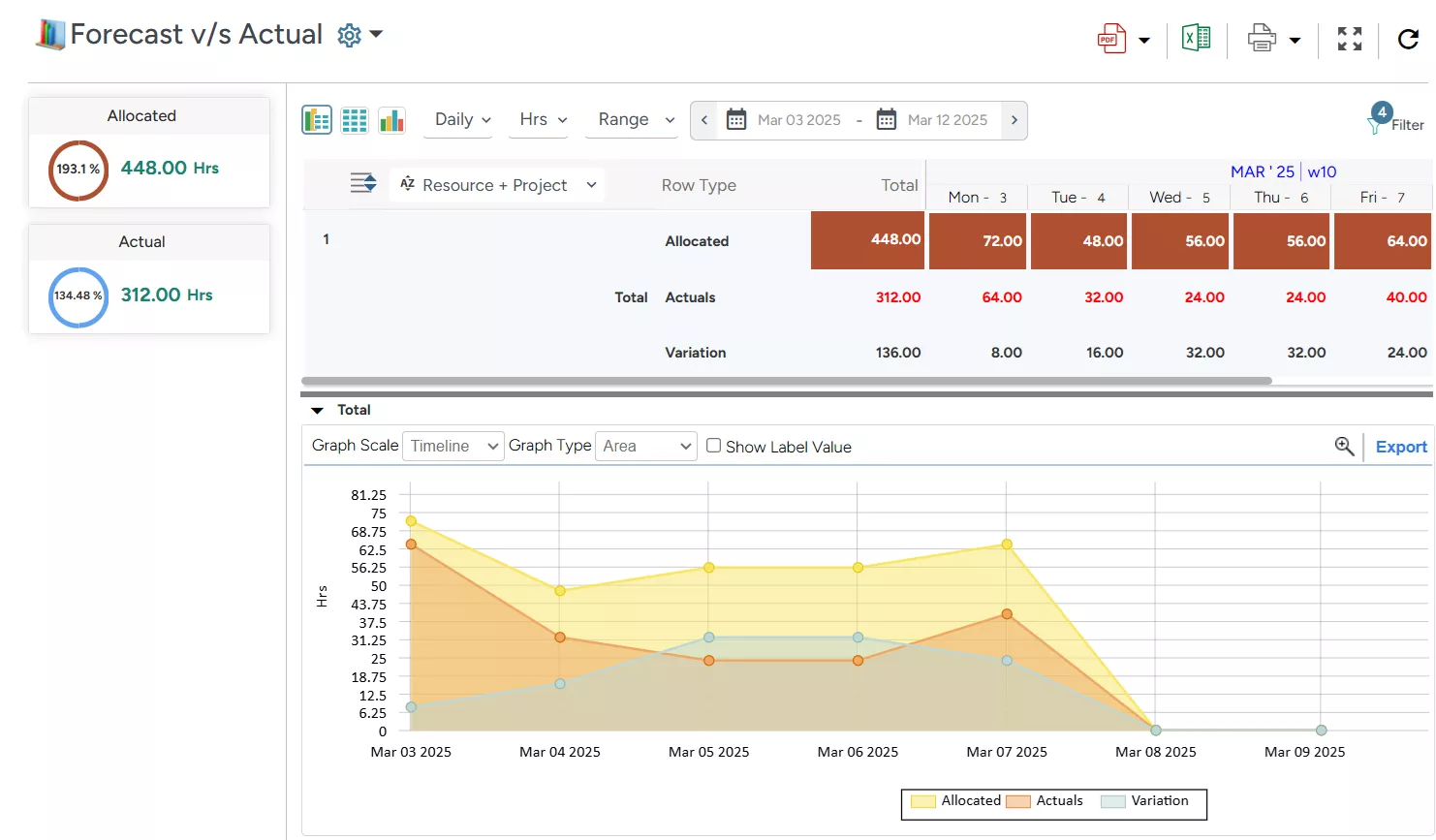 SAVIOM’s Forecast vs. Actual Time Dashboard helps managers spot variances between forecasted utilization and actual utilization, allowing them to take timely corrective measures.
SAVIOM’s Forecast vs. Actual Time Dashboard helps managers spot variances between forecasted utilization and actual utilization, allowing them to take timely corrective measures.
Skill Gap Index
The skill gap index evaluates the difference between the competencies required for a project and the existing skill levels within the workforce. It pinpoints critical roles and specialized expertise that may be lacking across the organization. By leveraging this insight, PMOs can implement proactive strategies such as targeted upskilling, recruitment, or cross-training to close capability gaps, enhance team readiness, and develop a workforce aligned with long-term business objectives.
The formula to calculate the skill gap index is:
| Skill Gap Index = [(Number of Skills Required – Number of Skills Available) / Number of Skills Required] X 100 |
|---|
Strategic Utilization
Strategic utilization assesses how effectively resources are deployed across initiatives that drive long-term business impact and align with organizational priorities. As a key PMO resource management metric, it helps ensure resources contribute to future growth, innovation, and competitive advantage. Thus, monitoring it helps PMOs maintain an optimal balance between day-to-day project delivery and strategic value creation.
The formula to calculate strategic utilization is:
| Strategic Utilization = [( Actual or Allocated Strategic Hours / Total Available Hours)] X 100 |
|---|
Billable Utilization
Billable utilization measures the percentage of an employee’s available hours dedicated to client-focused, revenue-generating work. A high percentage indicates efficient resource deployment across billable tasks, while a low rate signals excessive time spent on non-billable activities. It is crucial to monitor this KPI in PMO resource management to mobilize resources towards billable tasks, thereby boosting operational efficiency and maximizing revenue potential.
The formula to calculate billable utilization is:
| Billable Utilization = (Billable Hours / Total Available Hours) X 100 |
|---|
Continue reading: What Are Billable Hours? Key Strategies to Optimize Them
Productive Utilization
Productive utilization evaluates how efficiently resources are engaged across billable projects, strategic initiatives, and other high-value activities. It ensures that the workforce contributes meaningfully to both short-term profitability and long-term growth. Within PMO resource management, tracking the metrics helps boost overall employee productivity and improve profit margins.
The formula to calculate productive utilization is:
| Productive Utilization = [(Billable Hours + Strategic Hours + High-Value Project Hours) / Total Available Hours] X 100 |
|---|
Resource Cost Variance
This KPI evaluates the gap between projected resource costs and actual expenses over a defined period. While a positive variance indicates that resource spending remains on or below budget, a negative variance highlights overspending on salaries, contractors, or equipment, signaling a potential budget overrun. Tracking this metric helps PMOs control costs and maintain financial discipline across projects.
The formula to calculate resource cost variance is:
| Resource Cost Variance = (Forecasted Resource Cost – Actual Resource Cost) X 100 |
|---|
Resource Turnover Rate
The resource turnover rate indicates how frequently employees depart from the organization within a given timeframe. In PMO resource management, a high employee turnover rate can indicate challenges such as heavy workload, low engagement, or cultural misalignment. Hence, tracking this metric allows PMOs to proactively address workforce issues, enhance retention strategies, and build a stable, long-term talent pool.
The formula to calculate resource turnover rate is:
| Resource Turnover Rate = [(Number of Resources who Left During Period / Average Number of Resources During Period)] X 100 |
|---|
Cost per Resource Unit
Cost per resource unit calculates the total expenditure incurred for utilizing one unit of resource time, such as an hour, day, week, or month, within a defined period. This metric encompasses both fixed and variable costs, including salaries, benefits, overheads, and training expenses. By monitoring cost per resource unit, PMOs can determine whether their hiring & upskilling investments effectively align with overall project and portfolio goals.
The formula to calculate cost per resource unit is:
| Cost per Resource Unit = (Total Resource Cost During that Period / Total Resource Units During that Period) |
|---|
Cost per Hiring Resource
Cost per hiring resource evaluates the investment required to onboard a new resource. It includes external expenditures like job portal fees and advertising, as well as internal costs such as recruiter salaries and onboarding activities. In PMO resource management, measuring this KPI helps assess the effectiveness of the hiring strategy and identify opportunities to optimize costs while maintaining the quality of talent acquisition.
The formula to calculate the cost per hiring resource is:
| Cost per Hiring Resource = (Total Recruiting and Onboarding Cost / Total Number of Hires) |
|---|
Explore further: How to Build a Talent Acquisition Strategy in 8 Easy Steps?
In the following section, we will explore the best practices for modern PMO resource management in firms.
Best Resource Management Practices for Modern PMO
Outlined below are the essential resource management best practices that enable modern PMOs to optimize existing talent, drive strategic decision-making, and deliver maximum business value:
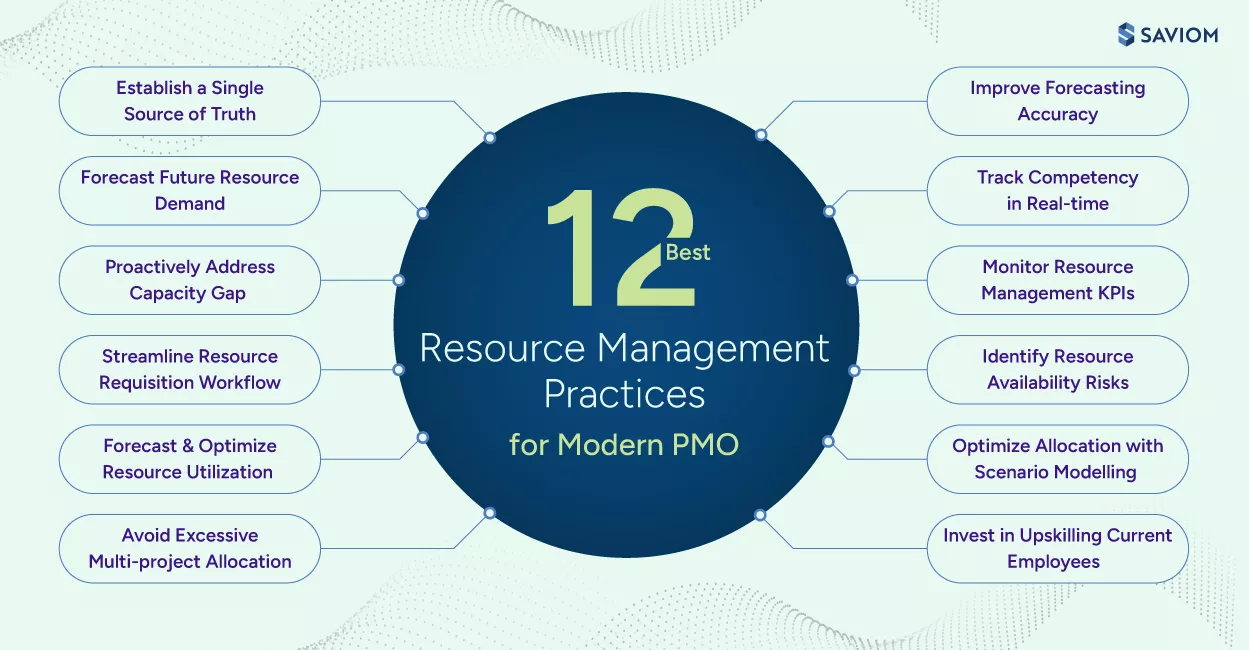
Establish a Single Source of Truth Across the Enterprise
Fragmented data often prevents PMOs from making timely and informed decisions. To overcome this, PMO heads can consolidate all resource-related information within a unified system that acts as a single source of truth. With this, they can gain holistic visibility into each individual’s skills, competencies, cost rates, availability, utilization, and capacity, enabling data-driven resource planning.
Moreover, by centralizing the data, PMOs can eliminate duplication of effort, minimize inconsistencies, and foster transparency and alignment across projects, portfolios, and programs. In parallel, enterprise-wide visibility and real-time insights enable PMO to shift from reactive to proactive resource management, enhancing operational efficiency.
Forward Plan and Forecast Resource Demand for Upcoming Projects
By leveraging 5th gen resource management, PMOs can accurately forecast future demands and identify the exact skills, capacity, and expertise required for forthcoming initiatives. This foresight enables PMOs to redeploy resources, upskill existing staff, or hire additional talent, ensuring workforce readiness during the execution phase.
Moreover, accurately forecasting resource demand enables PMOs to prevent last-minute firefighting, reactive hiring, or allocation bottlenecks that often derail project timelines. This ensures that project kickoffs are smoother, and delivery schedules remain stable, reinforcing operational efficiency and cost control across the portfolio.
Proactively Identify and Address Capacity Gap
Proactively identifying capacity enables PMOs to perform a comprehensive capacity vs. demand analysis to pinpoint the potential shortages and excesses of skills and capabilities in the internal resource pool. Identifying the gaps early helps PMO managers take corrective measures well in advance to ensure seamless project initiation and on-time delivery.
For instance, when capacity shortfalls arise, PMOs can address them through targeted hiring, upskilling, or reallocating resources from lower-priority projects. Conversely, in cases of excess capacity, they can assign resources to internal initiatives, provide temporary support to other teams, or offer additional capacity to clients at discounted rates, maximizing both productivity and profitability.
Want to dive deeper into resource capacity planning? Explore these blogs:
- What is Resource Capacity Planning? An Ultimate Guide for Managers
- What is Capacity Forecasting? An Ultimate Guide for Project Success
- Top Capacity Planning Challenges & 9 Ways to Overcome Them
Streamline Resource Requisition Workflow Across the Business
Establishing a standardized and automated resource requisition process is critical for PMOs as it helps streamline allocations across the enterprise. A well-structured workflow ensures project managers raise clear, detailed resource requests, outlining the required skills, expertise, and timelines. This gives resource managers sufficient lead time to evaluate availability and identify the best-fit talent.
The structured resource requisition approach further eliminates scheduling conflicts such as double-booking and unavailability. In addition, by embedding approval hierarchies, notifications, and tracking mechanisms, PMOs can minimize manual intervention, reduce administrative delays, and enhance accountability.
Forecast and Optimize Resource Utilization Early On
Accurate forecasting of resource utilization enables PMOs to gain a forward-looking view of how effectively workforce capacity is distributed across billable and strategic work. By analyzing future workloads, they can assess whether employees are engaged in high-value, billable work or are spending excessive time on low-priority activities.
This early visibility allows PMOs to identify inefficiencies and make timely adjustments to ensure that every resource is contributing to business objectives. Proactively optimizing utilization further helps balance workloads and maintain a steady focus on revenue-generating and strategically significant work.
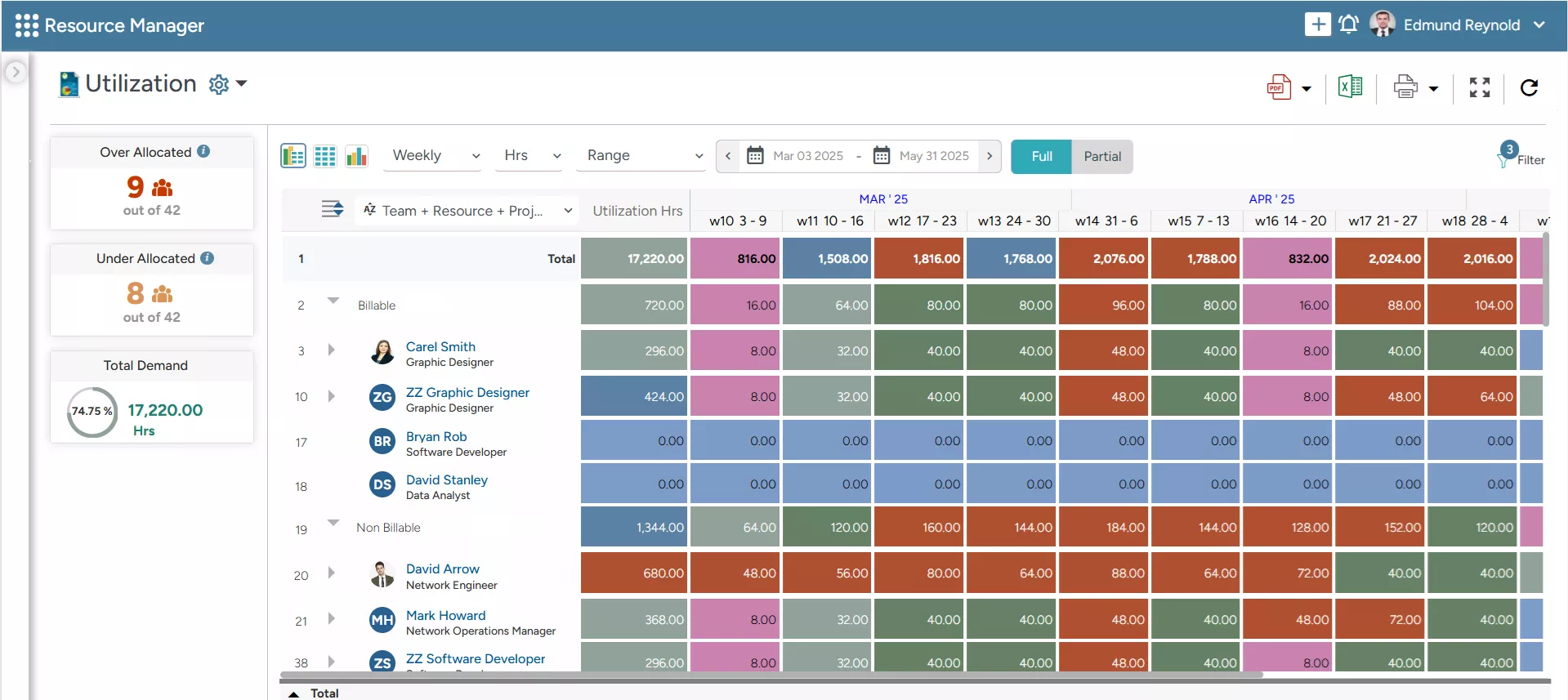 SAVIOM’s Color-Coded Heatmap highlights the utilization levels of every resource, enabling managers to identify under- and over-allocation.
SAVIOM’s Color-Coded Heatmap highlights the utilization levels of every resource, enabling managers to identify under- and over-allocation.
Avoid Excessive Multi-Project Allocation to an Employee
When resources are stretched across multiple projects, their focus and productivity tend to decline, often resulting in missed deadlines and compromised quality. Thus, it’s pertinent for PMOs to continuously monitor allocations, pinpoint project scheduling conflicts, and prioritize high-value or time-sensitive initiatives.
By doing so, managers can ensure employees focus on priority tasks first, reducing overutilization and stress. Additionally, PMOs can establish backups for key roles and redistribute tasks equitably across available talent to maintain a balanced workload and ensure employee well-being. This approach keeps employees engaged, prevents employee burnout, and ensures projects stay on track.
Delve deeper: What is Overallocation of Resources? 6 Ways to Avoid It
Improve Forecasting Accuracy by Comparing Forecast vs. Actual
Modern PMOs must regularly compare forecasted versus actual values for critical metrics such as resource utilization, costs, demand, and timeline to identify variances and improve planning accuracy. By leveraging historical data and market trends, PMOs can refine forecasting models, strengthen predictive capabilities, and make more informed, data-driven decisions.
For instance, if actual resource utilization is lower than what was forecasted, it may indicate that some resources are under allocated or that certain projects didn’t progress as planned. Recognizing such gaps beforehand allows PMOs to revisit their assumptions, reallocate capacity where needed, and make future forecasts more realistic and reliable.
Track Competency in Real-Time Across the Workforce
Real-time tracking of workforce competencies provides PMOs with complete visibility into employees’ skills, certifications, and experience levels. This up-to-date insight allows precise alignment of available skills with current and upcoming projects, ensuring that the right people are deployed to the right roles at the right time. It also helps maintain workforce flexibility as project priorities or client needs evolve.
Moreover, by maintaining a centralized skill repository, PMOs can quickly identify capability gaps and take proactive steps such as targeted upskilling, cross-training, or strategic hiring. Consequently, this continuous visibility helps strengthen project delivery and build a future-ready, adaptable workforce aligned with long-term organizational goals.
Monitor and Optimize Resource Management Key Performance Indicators (KPIs)
Monitoring key resource KPIs, such as utilization rates, capacity, availability, and staffing lead times, enables PMOs to accurately evaluate workforce performance and overall operational efficiency. These quantifiable indicators provide early visibility into discrepancies such as underutilization, overallocation, or emerging skill gaps, enabling timely corrective action before they impact project delivery.
By analyzing KPI trends over time, PMOs can refine allocation strategies, enhance future project planning, and strengthen workforce readiness. Additionally, continuous performance tracking ensures that resources remain optimally aligned with overarching business goals and evolving portfolio priorities, reinforcing strategic alignment.
Explore further: Resource Management KPIs: 15 Metrics to Ensure Resource Efficiency and Project Success
Identify and Mitigate Resource Availability Risk
Staying ahead of the resource-related risks is critical for modern PMOs to ensure seamless project execution. For this, they must consistently monitor current and upcoming resource schedules to identify potential availability issues. This includes tracking key factors such as planned leaves, holidays, attrition, and training commitments, helping managers forecast shortages before they disrupt delivery timelines.
By anticipating these risks, they can take corrective measures, such as building internal resource buffers or sourcing contingent workers from empaneled vendors, to lessen the impact. As a result, this proactive approach minimizes project delays, prevents budget overruns, and ensures uninterrupted progress even during unforeseen resource fluctuations.
Optimize Resource Allocation with Scenario Modeling
According to the GoodFirms survey, “31.1% of organizations have reduced their operating costs with the help of scenario planning.”
The above statistics clearly underscore how scenario modeling aids firms in dealing with potential budget overruns and improves cost efficiency. By simulating various resource allocation possibilities, PMOs can evaluate their impact on key parameters such as availability, capacity vs. demand, and utilization. Moreover, comparing multiple “what-if” scenarios enables them to determine the most efficient way to utilize available talent within existing budget, time, and capacity constraints.
Moreover, scenario modeling helps PMO managers to anticipate potential risks and bottlenecks, allowing them to design contingency plans in advance. This proactive, data-driven approach equips organizations to remain agile and resilient amid market volatility, economic uncertainty, and evolving client demands.
Upskill Current Employees Instead of Hiring New Ones
PMOs should prioritize developing internal talent through targeted upskilling programs rather than relying solely on external hiring. Investing in employees’ growth reduces external recruitment costs and also ensures faster adaptability to evolving projects and business requirements. Cross-training further helps build a versatile workforce capable of managing diverse and complex assignments.
Moreover, by nurturing existing talent, PMOs can strengthen succession planning and promote effective knowledge sharing across teams. This approach ultimately enhances employee satisfaction, boosts long-term engagement, and ensures business continuity while creating a future-ready workforce that can seamlessly support shifting organizational priorities.
Dive deeper: How Can Retraining/Upskilling Future-Proof Your Workforce?
Having explored the PMO resource management best practices, let’s now see how SAVIOM’s advanced capabilities can help PMOs transform their operating model.
How SAVIOM Software can Help PMO in its Transformation?
SAVIOM’s 5th gen resource management software helps PMOs redefine how they plan, allocate, and optimize their resources. Let us understand how:
All-in-One Resource Planner
SAVIOM’s all-in-one resource planner offers a comprehensive suite of advanced functionalities, such as:
- The multi-dimensional analysis allows PMOs to slice and dice the enterprise resource plan across various dimensions such as role, experience, expertise, location, cost, capacity, and utilization. Further, with 360-degree visibility into the talent pool, they can effectively manage geographically distributed project teams with ease.
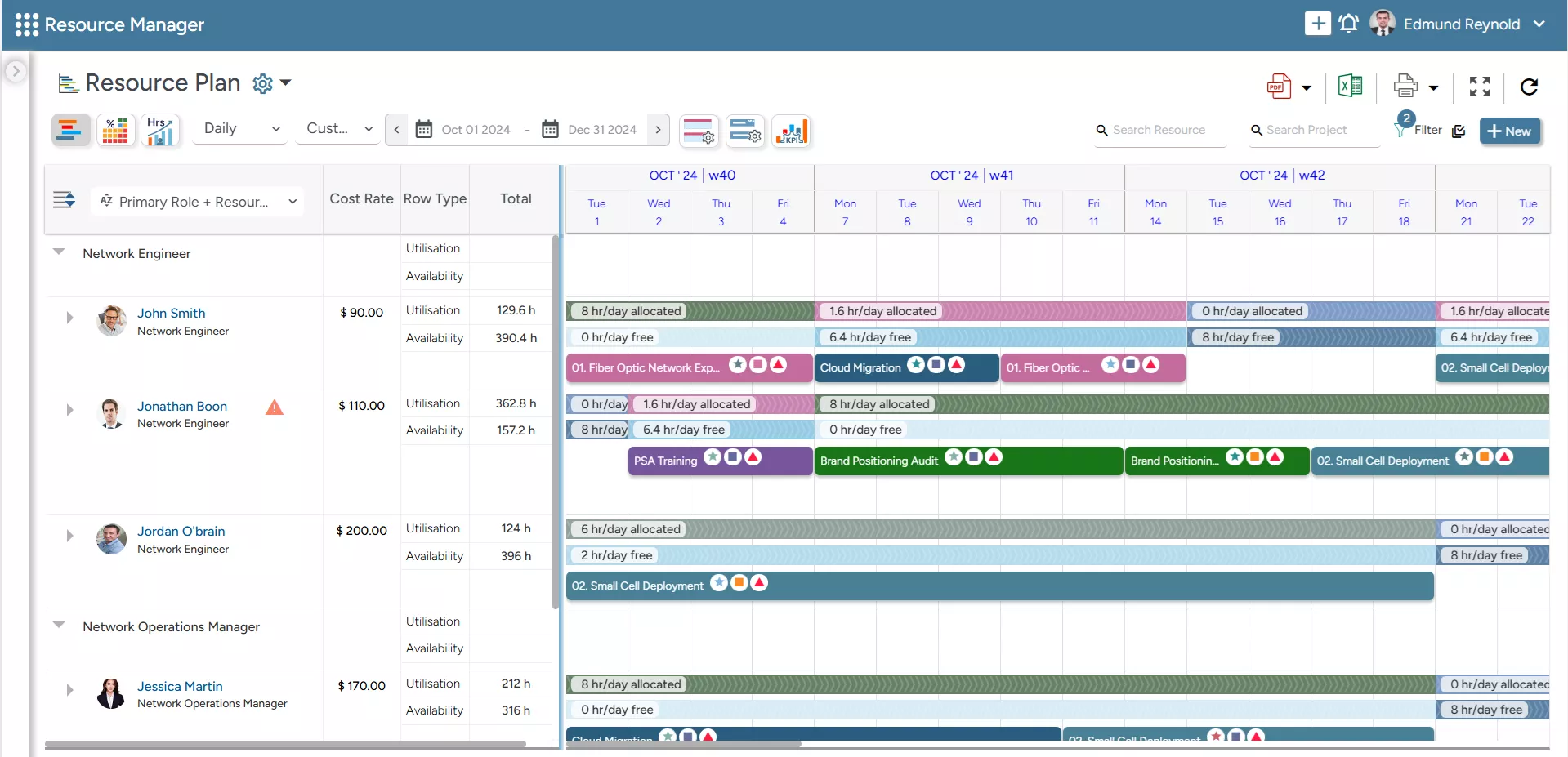 SAVIOM’s All-in-One Resource Planner offers 360-degree visibility into employees’ expertise, experience, and availability across the enterprise.
SAVIOM’s All-in-One Resource Planner offers 360-degree visibility into employees’ expertise, experience, and availability across the enterprise.
- Its embedded capacity planning lets PMOs assess short and long-term staff shortage/excess and take course-corrective action to bridge the demand gap. This gives them lead time to take corrective actions to combat capacity surplus or deficit.
- The embedded heat mapping helps PMO managers quickly identify over- or underutilized personnel and optimize their workloads to improve the resource health index.
- Next, the intelligent match-making function ensures that PMOs assign the right personnel to the right project at the right time and cost, thereby facilitating competent allocation.
- Now, its early warning system alerts PMOs when there are instances of overloading, double-booking/scheduling conflicts, booking during time off, etc. This gives them ample lead time to take corrective measures to minimize variances and maintain optimal productivity levels.
- Finally, the smart KPI forecaster is another powerful feature available only in SAVIOM. It helps PMOs gain foresight into resource-centric KPIs such as capacity, utilization, availability, skill shortages, people-on-the-bench, etc., enabling data-driven decision-making.
Resource Forecasting
SAVIOM offers a multi-dimensional resource forecasting feature that helps PMOs foresee future pipeline project demands to understand resource requirements. Moreover, with a forecast vs. actual cost report, they can control project budgets and enhance future financial planning.
Resource Optimization
The what-if analysis feature facilitates scenario-based resource optimization. It allows PMOs to create and compare various scenarios and arrive at the most profitable project resource plan. Thus, it helps them mitigate resourcing bottlenecks and maintain an optimized workforce.
Talent Planning
The tool’s real-time competency matrix allows PMOs to record, track, and update every skill, expertise, certification, etc., available within the organization. This helps in identifying skill gaps and initiating appropriate learning and development programs. Thus, it allows firms to maintain an adaptable talent pool capable of undertaking advanced, multi-faceted projects.
Task/Time Management
The task management features of the tool enable PMOs to ensure that relevant, cost-effective professionals are allocated to every project task or activity. Additionally, the time-tracking facility provides timesheets and automated approval workflows to help managers gauge and optimize billable utilization.
Business Intelligence
Besides, the real-time BI reports and dashboards provide PMOs with in-depth visibility into demand shifts, utilization trends, etc. It allows them to identify challenges and make swift, data-driven decisions. Furthermore, these business intelligence reports and dashboards are highly customizable, thereby minimizing information clutter.
Workflow & Integration
SAVIOM lets PMOs automate resource requisition workflow, skill-management workflow, etc. It also offers both automatic and manual integration with various disparate systems. Further, data can be imported into and exported from SAVIOM using Excel, with the tool offering customizable templates to streamline resource-centric processes.
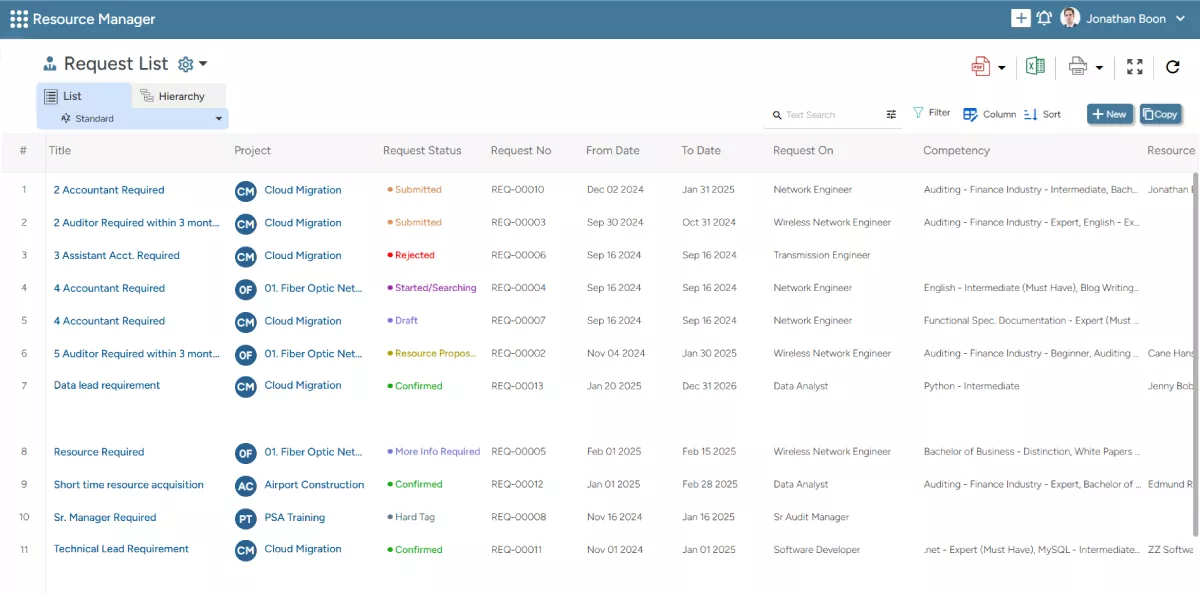 SAVIOM’s Automated Resource Requisition Workflow allows managers to raise resource requests and ensure timely allocations.
SAVIOM’s Automated Resource Requisition Workflow allows managers to raise resource requests and ensure timely allocations.
Highly Configurable and Adaptable Solution
As organizations progress through different maturity stages, rigid, one-size-fits-all systems quickly become obsolete. They need scalable, adaptable solutions that evolve with changing business dynamics. For PMOs, this flexibility is essential to manage complex portfolios and maintain strategic alignment. SAVIOM’s highly configurable resource management platform meets this demand by allowing workflows, reports, and integrations to be tailored to unique requirements at every stage, making it a future-ready solution.
Pioneer and Market Leader of Resource Management
With over two decades of expertise, SAVIOM has established itself as a global pioneer and trusted authority in resource management. Its solutions are trusted by Fortune 500 companies and leading enterprises across 50+ countries, including Verizon, Fujitsu, ABB, and Grant Thornton. By empowering PMOs to optimize resources and align talent with strategic priorities, SAVIOM plays a pivotal role in advancing organizational maturity. This proven track record underscores its reputation as the preferred choice for businesses seeking to strengthen their resource planning practices and accelerate sustainable growth.
Conclusion
Project Management Offices (PMOs) are the strategic backbone of modern enterprises, driving project excellence and organizational performance. However, with rising complexity and dynamic project demands, conventional PMO frameworks often fall short. 5th Gen resource management transforms this landscape by equipping PMOs with real-time insights and advanced capabilities to optimize resources, boost agility, and deliver sustained operational excellence.
